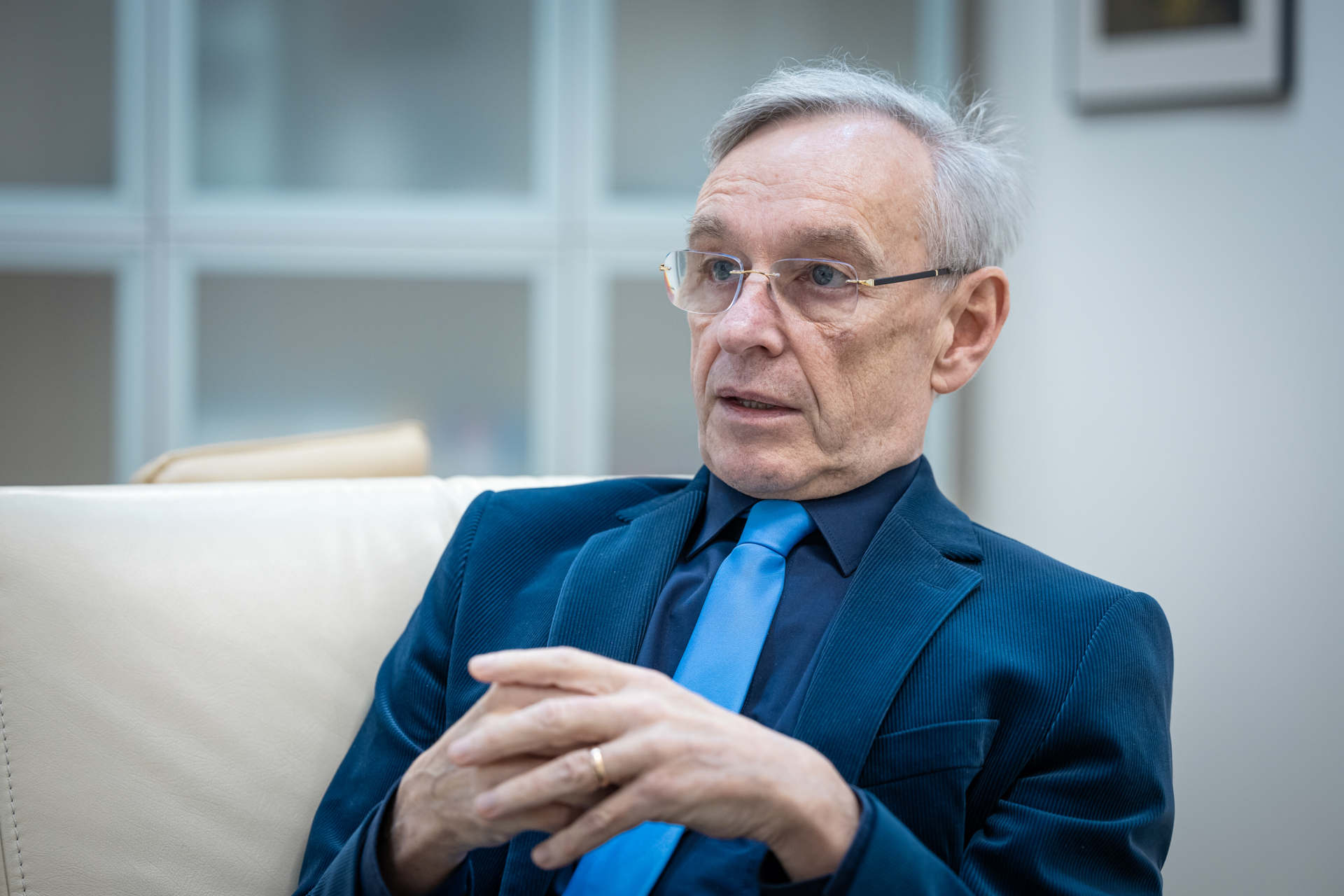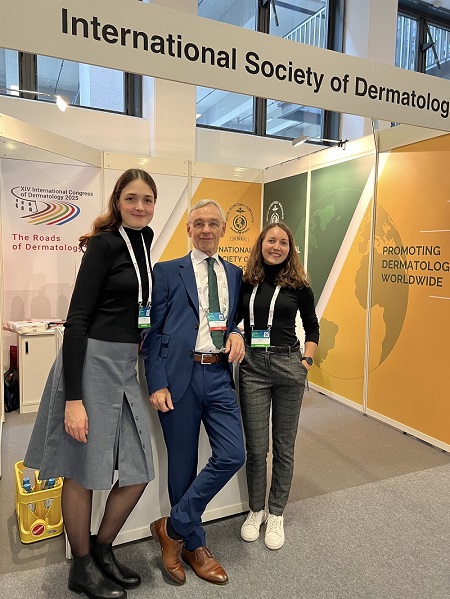
The US-based International Society of Dermatology commissioned Dr. Lajos Kemény, professor of dermatology and immunology at the Department of Dermatology of the University of Szeged, to be the editor-in-chief of the International Journal of Dermatology. Editing this prestigious magazine means prominence in the profession. During its sixty-year history, the magazine's leadership moved from American universities to Europe for the first time. For the past 23 years, the editors-in-chief have been selected from the professors of the world-famous Mayo Clinic. Now, Dr. Lajos Kemény reads 20-25 articles a day, and during the review of the articles he keeps in touch with dermatology researchers living in all parts of the world. We talked with the Széchenyi Award-winning doctor and university professor about his new work, the stories, and new challenges of dermatological research in Szeged.
– What kind of journal is the International Journal of Dermatology? How is it different from other dermatology journals?
– Our magazine accepts publications from all over the world. In addition to general dermatology, it once provided publication opportunities for research related to tropical diseases. Although its focus has changed somewhat, it still focuses on the dermatology of tropical, medically underserved areas, and the population of color. It is difficult for colleagues living in African or Asian countries to showcase their research on an international level: they have to compete with research coming out of American or European centers, and their publications rarely make it into the biggest journals. We also provide space for these works and help researchers. For publications from such an environment, article reviewers usually seek suggestions so that the work can be published. The profile of the magazine is therefore very broad, in addition to the different characteristics of skin diseases occurring in various races, it also focuses on populations living in disadvantaged conditions.
– How does it feel to be the editor-in-chief?
– It is not an easy task, when a paper arrives you have to decide where it should go next, whether it should be sent to one of the column editors or not. Nowadays, I receive 20-25 papers a day, and I have to read at least the abstract, but often the entire article, to decide whether they are suitable for consideration. After that, you have to decide which column editor the article will go to, and then you have to look for reviewers. At the journal, all scientific editors work for free, because this work means professional prestige, but it is becoming more and more difficult to find reviewers for each publication out of favor. I myself was otherwise familiar with this job, I knew what to expect, but it turned out to be a bigger task than I thought. One day before applying, I received the number that the International Journal of Dermatology manages approximately 4,500 publications annually.
– The discipline in which such a large amount of work is fuelled only by professional prestige is worthy of recognition.
– The magazine has great professional prestige, in its 60-year history, from its founding, the chairman of the editorial board and the editors were always in the United States. The editor-in-chief and the staff have worked at the Mayo Clinic for the last 23 years. This is the first time in the newspaper's history that the professional management has moved out of the United States. Earlier, I was also asked to apply for the position of editor-in-chief of the European Journal of Dermatology, but at that time I did not see clearly whether the handover of the department head of the Department of Dermatology and Allergology would take place in July 2023. When it became obvious that Professor Rolland Gyulai was applying for the position and would be happy to come to Szeged at my request, they encouraged me to apply for the editor-in-chief of the International Journal of Dermatology. I applied for the position at the journal at Christmas 2022 because I already knew that from July some of my time would be freed up. In addition, managing the American journal not only means personal prestige as a researcher, but the name of the Dermatology and Allergology Clinic of the University of Szeged also appears on the front page of the journal. Not to mention that in the professional correspondence of the 4,500 publications received each year, the names of the university and the clinic appear after my name. Those who were not familiar with it before will get to know it now. In some cases, of course, they scold you because of the "rejected" answer, but at other times they are happy. The work of the editor-in-chief is also supported by the University of Szeged, partly by providing the editorial office, and partly by employing editorial staff.

The editorial staff of the International Journal of Dermatology at the Berlin conference: Lili Beke, Lajos Kemény, Anita Biró
– As editor-in-chief, do you read incoming publications differently than before, as a researcher?
– Until now, I also liked to read scientific articles that were not closely related to my research field, because they provide a perspective outside the profession. It was my hobby and now it has become my job. I still love it, of course, but I put down the work done in a different way. After all, I will open the computer the next day and 20 articles will arrive again, even though I have completed the previous day's work. In addition, an article returns several times, the articles sent for review are seen again several times after the revisions; so there is also a side of work that does not exactly become a hobby.
– Do you feel uncomfortable rejecting articles?
– It's also not a pleasant part of the job when a letter of complaint comes from a colleague because we rejected his article, even though he thinks it's worth publishing. These must also be answered somehow. I once had to reject an article by a top US academic, so I spent three hours working on the letter explaining why we couldn't accept it. On the other hand, it is fantastic that I am in regular contact with very, very good colleagues from all kinds of countries.
– In the imprint of the paper, I counted 60 researchers from different parts of the world who are working on the journal. How many do you know personally?
– Let's say fifty of them, usually from conferences. Last autumn, in connection with a large European conference, we organized the first editorial board meeting at the Hungarian embassy in Berlin, where we were received by Ambassador Péter Györkös. At the congress venues, it was incredibly expensive to reserve any kind of place in Berlin, even when empty, their rental fee was 1,500 euros for an hour. We, on the other hand, had no funding, so I thought we would ask the embassy if they would host us, and to our delight they agreed to do so.
– It is clear from the journal's abstracts that the articles are not only about dermatology but also about a wide range of other disciplines. Where is the border of dermatology?
– Dermatology is a very broad profession, in different countries it includes different border areas. Sexually transmitted diseases are dealt with by a separate profession in England, while in Europe they are part of dermatology. There are border areas between infectology and dermatology too; HIV infections, for example, belong to dermatology in many countries, and to infectology in others. There are also tropical diseases that can be considered dermatological problems. In some countries, there is a separate department for tropical diseases at the universities, but these diseases are often diagnosed with skin symptoms, so dermatologists must know about them. Immunology is also an extensive border area, depending on the patient care structure in each country, and if immunologists, rheumatologists, or internists treat these patients. The treatment of serious skin and soft tissue infections, autoimmune and allergic diseases affecting the skin, as well as the care of skin tumors is also a border area that requires serious expertise in internal medicine, surgery, immunology, and oncology.
– During your research career, what was the biggest breakthrough you experienced in the field of dermatology, which greatly changed your medical work?
– If we talk about dermatology globally, the big breakthrough took place between 2000 and 2010, when biological drugs opened up completely new possibilities in the treatment of psoriasis, which I also researched. At the same time, these also changed the prestige of our profession. Psoriasis was previously not completely treatable, even though it is a common disease, which seriously affected the quality of life of the patients. Before that, we put all kinds of ointments on the patient, from head to toe, and nobody was really satisfied with that. However, if there is a medical profession that cannot help the patient, its evaluation will not be good either. However, in the 2000s, more and more therapies came along, starting with biological drugs, and we were able to completely relieve an ever-increasing percentage of patients. It was a turning point when the whole of dermatology was transformed. Not only psoriasis, but also eczema, autoimmune hair diseases, and several other chronic, previously incurable skin diseases, as well as cancer, have become treatable with a very, very good chance.

Photo: Ádám Kovács-Jerney
– How often do you have to relearn the profession - as they say - for today's development?
– In the areas where science is boiling - annually. If not the entire profession, but in some areas, the change is so rapid today that one can only scratch one's head. Ours is a relatively small profession, but even within this, some areas have become so complex that even the sub-areas within them represent an additional profession. It is difficult to fully follow everything new in every field, but of course, it is not impossible, and as head of department it was also my job to see through the developments. We organized the work in such a way that the colleague responsible for the given area had to follow the topic closely. With any very new procedure, the side effect profile is also very new, and a thorough knowledge of the field requires a whole person. Examining the mechanism of action and side effects of newer drugs requires quite complex research, which we have to carry out. Of course, I am not talking about the diseases from which we have been able to cure patients for a long time: in the treatment of fungal skin diseases, for example, no new therapy has appeared for fifteen years, since we have suitable treatment procedures, we do not need to learn them again, unless it's to remember what kind of fungi there are.
– Are there any skin diseases that have become widespread due to climate change or lifestyle?
– Unfortunately, more and more patients suffer from malignant skin tumors. The main factors for this are climate change and lifestyle, as well as the fact that we live longer and are older. Skin tumors are mainly caused by increased UV exposure, in Hungarian conditions mainly by sunbathing habits. We don't take care of ourselves. People think that brown skin is beautiful; this belief may already be dying out, but due to the strong UV exposure of beach holidays, tumors can appear fifty years later. A hundred years ago, such a problem did not exist, when people walked on the beach with umbrellas. Typically, the inhabitants of desert areas with strong sun are dressed up to the chin, and it does not even occur to them to walk around in swimming trunks. In addition, at the global level of dermatology, people moving to other areas can also be problematic. For example, white people immigrated to Australia en masse; now they are the ones who suffer the most from skin tumors caused by UV radiation, while the Australian Aborigines do not have this at all. Obesity and the many resulting problems that affect the immune system, our circulatory systems, and the condition of our veins are also related to lifestyle. In the case of diabetes, for example, there are more obese people and more related dermatological complications.
– You are known worldwide by the profession for your achievements in the excimer laser treatment of skin diseases. What was the background to your use of laser equipment as a doctor?
– A Faroese doctor named Finsen already won the Nobel Prize for medicine in 1903 for light therapy. He cured an abdominal TB infection with a UV lamp; patients were opened and exposed to UV light. A third of them died, but seven out of ten survived a disease that previously had a 100 percent mortality rate. So, it's been known for a long time that light is good for treating several skin conditions, and light therapy lamps have been around for a long time. The innovation we developed at the Dermatology Clinic of the University of Szeged was excimer laser therapy in the 1990s. Back then, there were no biological drugs, if a patient had extensive skin symptoms, we put them in the cabin and knew how much light they could get without increasing the risk of skin cancer. The patient was covered in UV light from head to toe. This helped a lot, but we also knew that UV light is carcinogenic. We started to think about a light therapy device that can be used to focus the light so that the symptom-free skin is not stressed with it. It was easy to see that such a local, non-dispersive, high-energy light source could be found among lasers. So I went to see Gábor Szabó and Zsolt Bor at the Department of Optics and Quantum Electronics of SZTE. We knew we needed a UV spectrum between 300 and 320 nanometers, and they happened to have an experimental laser at 308 nanometers that they weren't using. They said we can take it. Together with Gábor Szabó, and if I remember correctly, with the help of a patient carrier, we pushed the large device on a patient transfer stretcher to the clinic, where we worked on it a lot with Ferenc Ignácz and dermatologist colleagues. Our research group was the first to publish an article on the dermatological effectiveness of the excimer laser. Based on this, they started manufacturing this laser device in the United States, thanks to which patients are cured and two million treatments are carried out a year.
– In your previous interviews, you told the story of how the scientific results first published by your clinical research group became a utilized medical device, which is now spread all over the world, and yet the discovery did not result in money. What advice do you have for today's researchers at the University of Szeged?
– Indeed, we did not get a patent for excimer laser therapy; we were careful, but not enough. The answer at the time was that the laser device had already been patented, and we did not know that there was also a method patent in the United States that could be used to protect the procedure. Two years later, the same thing happened again in the excimer laser treatment of pigment deficiency disease: an American dermatologist filed a patent for the method when we already had published results. It was bought for two hundred thousand dollars. Of course, the professional community knows that the priority of discovery is ours, but we fell short of the financial benefits, not because we were amateurs, but because at that time the entire patent office in Hungary was not on top of the situation. Otherwise, method patents are not strong enough; after the first method patent was filed for the excimer laser treatment of psoriasis and pigment deficiency disease, at least fifteen more were filed, as the same technology is registered as a different patent with a small modification. Today, the Directorate for R&D and Innovation of the University of Szeged helps researchers protect new ideas with a "one-stop shop".

Photo: Ádám Kovács-Jerney
– The Dermatology Clinic of the University of Szeged has long been famous for the immunological research conducted here. What are the prospects for skin immunology research today?
– First of all, when we talk about research results, we must never forget where we come from. A good research group not just suddenly appears out of nowhere to save the world. We can achieve something based on traditions. At our Dermatology Clinic, Miklós Simon was the first to say that experimental dermatology should be done. Since he did not have enough experience with it, he invited Attila Dobozy from the then Institute of Physiology of the Medical University of Szeged to start research on skin physiology. Following Attila Dobozy, research on the immunology of the skin began, and everyone continued this, myself included, always shedding light on new aspects. We have always been primarily interested in the function of epithelial cells; partly they form a mechanical barrier and thus protect the body from external infections, and partly substances are also produced in the skin that inhibit the growth of bacteria. We investigate the mechanism of how bacteria affect epithelial cells and the role of epithelial cells in the functioning of the skin's immune system, especially in the case of inflammatory psoriasis.
– Research related to the immune system of the skin is now included in the program of the Hungarian Center of Excellence for Molecular Medicine (HCEMM) in Szeged. How long have molecular biology methods been used in dermatology research in Szeged? If I guess correctly, this was also a big change...
– It was a big change indeed: when I came home from Germany in 1991 from the Humboldt scholarship, I told Attila Dobozy that we should go in the direction of molecular biology. This primarily required know-how and a critical mass of researchers. We didn't really have that back then. At the start, our initial collaboration with the Szeged Biological Research Center (SZBK) was very important, as they had sufficient knowledge of molecular biology. So I asked Ferenc Nagy, the current general director of the SZBK. By the way, he is my brother-in-law, so during a Christmas conversation I could bring up the topic that we need a molecular biologist; whom could he recommend? He replied that he has a colleague, who just came home from Japan, and who doesn't have a project at the moment, he suggested I should ask her. The mentioned colleague was Márta Széll (now strategic vice-rector of SZTE). She started working in our research group, and then we worked together for many, many years on dermatological research until she switched to genetics.
– What do you think will be the next "big leap" in research?
– Sometimes I feel like we're running after a train; sometimes we manage to catch up with it, to climb up a bit, and then there are times when we feel that we have fallen and have to run again. We constantly tried to introduce the most modern therapeutic procedures, but the train got faster and faster. Now I feel again that we have fallen from it, so we have to get up and try again. We can already do molecular genetics, we can examine the expression of RNA, DNA, and proteins at the level of tissue samples, but it takes more than that to sell new results in a prestigious journal. These days, tests must be carried out at the cellular level: in the cells of the diseased tissue, we must know individually how the expression of proteins and genes develops, how they follow each other, what affects what, and we must be able to put these together. Research costs have also increased a lot, and today it requires extremely serious IT. This is a direction of global biology that cannot be avoided. We have to work with a more robust amount of data than ever before, and this requires the kind of new knowledge that a research group does not collect overnight.
– Is artificial intelligence already an established method in dermatology research? How much can you trust the artificial intelligence used in birthmark screening?
– Artificial intelligence is already used in many ways in research, and of course, I am not thinking of Chat GPT here. I recently asked one of our Ph.D. students researching molecular biology, who will soon be graduating from the clinical doctoral school here but is doing his research in the United Kingdom, where he sees the role of artificial intelligence. He is very happy about it, he replied, because until now he had to pay a lot of money to those who wrote the simulation programs according to his expectations. These codes are now written for him by artificial intelligence. Otherwise, artificial intelligence has been present in our daily patient care for a very long time. We already had a device for birthmark analysis based on machine learning 20 years ago. Of course, machine learning tools do not give a diagnosis, only the risk of a birthmark on the scale of danger. They are constantly developing, there are newer and newer ones, and they can help the doctor's work quite well, but the doctor decides in the end. I can imagine that in 5 years, it will most likely be standard procedure for someone to get an opinion based on a photo about whether or not they should go see the doctor with their birthmark.
Written by Sándor Panek
Translated by NKI
Featured image: Dr. Lajos Kemény, dermatologist-immunologist, professor at the Dermatology Clinic of the University of Szeged. Photo: Ádám Kovács-Jerney

